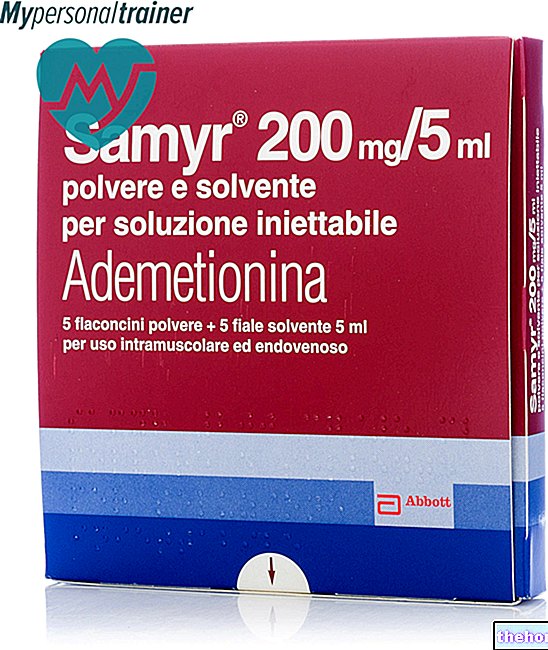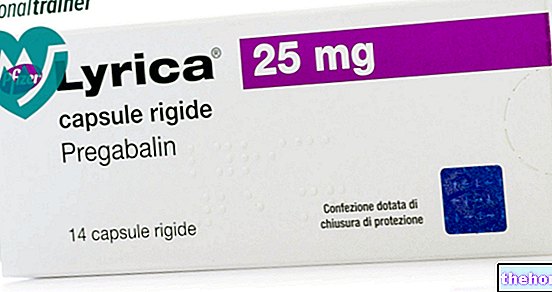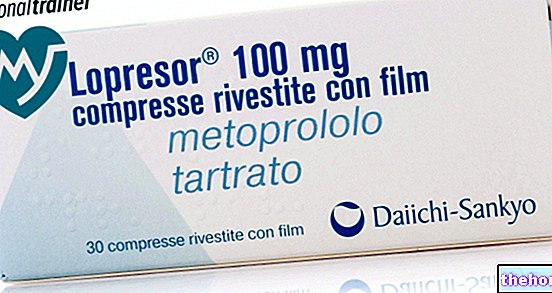Active ingredients: Prochlorperazine
STEMETIL 5 mg film-coated tablets
STEMETIL 10 mg suppositories
Indications Why is Stemetil used? What is it for?
Antiemetic and anti-nausea.
Treatment and prevention of vomiting and nausea of all kinds.
Contraindications When Stemetil should not be used
- hypersensitivity to prochlorperazine or other phenothiazines and / or to any of the excipients
- comatose states
- CNS depression, particularly that induced by CNS depressant substances (alcohol, barbiturates, narcotics, etc.)
- bone marrow depression
- pheochromocytoma
- severe impairment of liver and kidney function
- do not use under two years and in pediatric age
- period before surgery
- first trimester of pregnancy.
Precautions for use What you need to know before taking Stemetil
Special attention requires its use in the elderly and children since the risk of extrapyramidal reactions is higher.
Stemetil, like other phenothiazines, should be used with caution in patients with hepatic or renal insufficiency, heart disease, myasthenia gravis, severe respiratory disease, prostatic hypertrophy, urinary retention, intestinal obstruction and narrow-angle glaucoma.
Caution is advised in patients with epilepsy as phenothiazines may lower the seizure threshold. Some caution should be exercised in patients with Parkinson's disease as deterioration of the disease may occur.
As with other phenothiazines, caution is advised in patients with leukopenia and / or neutropenia, in patients taking drugs known to cause neutropenia, in patients with a history of myelosuppression or due to concomitant disease, radiotherapy or chemotherapy. A periodic check of the blood count should be performed, which should be requested promptly in the event of an unexplained infection or fever.
Elderly patients are more predisposed to the adverse effects of phenothiazines due to the risk of orthostatic hypotension. It is recommended that blood pressure be checked periodically in patients over 65 years of age.
Interactions Which drugs or foods can modify the effect of Stemetil
The CNS depressant action of phenothiazines can be enhanced by alcohol, use of anesthetics, narcotics, sedatives, etc. Respiratory depression may occur. The anticholinergic action of phenothiazines can be enhanced by other anticholinergics and cause constipation, urinary retention, heat stroke, etc.
Decreased bioavailability
antacids, parkinsonism drugs, and lithium can interfere with the absorption of antipsychotics.
There is an increased risk of ventricular arrhythmias with drugs that prolong the QT interval, including antiarrhythmics, antidepressants and other antipsychotics.
There is an increased risk of agranulocytosis when phenothiazines are used together with drugs with myelosuppressive potential, such as carbamazepine, sulfonamides or cytotoxics.
With lithium there is an increased risk of extrapyramidal effects and neurotoxicity.
Tell your doctor or pharmacist if you are taking or have recently taken any other medicines, even those without a prescription.
Warnings It is important to know that:
Extrapyramidal symptoms (parkinsonian symptoms, dystonias and dyskinesias) depend in part on the dose, duration and individual sensitivity. With the suspension of the drug there is a remission of parkinsonian symptoms.
Phenothiazines can alter the regulation of body temperature so caution is recommended during the very hot season (risk of hyperthermia) or very cold (risk of hypothermia).
Neuroleptic Malignant Syndrome (NMS): is a potentially fatal condition associated with treatment with prochlorperazine or other neuroleptics used for antipsychotic purposes. The clinical manifestations of NMS are: hyperpyrexia, muscle stiffness, autonomic nervous system dysfunction (irregular pulse or blood pressure, sweating, tachycardia, arrhythmias), changes in consciousness that can progress to stupor and coma. It is essential in these cases to discontinue drug therapy.
Patients treated with phenothiazines should avoid excessive exposure to sunlight, resorting, if necessary, to the use of special protective creams.
The antiemetic action of phenothiazines can mask the signs of overdosage of other drugs or can make it difficult to diagnose concomitant diseases especially of the digestive tract or CNS, such as intestinal obstruction, brain tumors or Reye's syndrome.
For this reason these substances must be used with caution in association with chemotherapeutic drugs with antiblastic action which at toxic doses can cause vomiting. The drug can induce a depression of the cough center which increases the risk of aspiration of vomit.
Prolonged doses cause an increase in the serum level of prolactin with possible effects on target organs.
As with other neuroleptics, cases of prolongation of the QT interval have been reported very rarely. Caution should be exercised especially during the initial phase of treatment in patients with predisposing factors for ventricular arrhythmias such as significant heart disease, metabolic alterations such as hypokalaemia and hypomagnesaemia. , concomitant use of drugs that lengthen the QT interval. It may be useful to monitor the electrolyte picture and the ECG, particularly during the initial phase of treatment.
Pregnancy and breastfeeding
Pregnancy: do not administer in the first trimester of pregnancy. In the following period the drug can be used only when considered essential and always under the direct supervision of the doctor. The use of the drug as an antiemetic in pregnancy is not recommended.
It has been reported that the drug can prolong childbirth, so avoid its administration until the cervix has reached a dilation of 3-4 cm.Side effects on the fetus include lethargy, paradoxical hyperexcitability, tremor and a low Apgar index.
Ask your doctor or pharmacist for advice before taking any medicine.
Breastfeeding: as phenothiazines can be found in milk, breastfeeding should be discontinued during treatment.
Effects on ability to drive and use machines
Since phenothiazines induce sedation and somnolence, patients should avoid driving and using machines while using Stemetil.
In case of known intolerance to some sugars, contact your doctor before taking this medicine.
Dosage and method of use How to use Stemetil: Dosage
Oral use
Adults: For the treatment of the acute attack of vomiting and nausea, the recommended dose is one tablet three times a day at regular intervals.
For the prevention of vomiting and nausea the recommended dose is 1-2 tablets.
Elderly: Reduced doses are recommended for patients over 65 years of age.
Children: use reduced doses.
Rectal use
Adults: the recommended dose is 2 suppositories a day, one in the morning and one in the evening. In some cases, such as for example in overwhelming vomiting, you can initially administer 1 or 2 suppositories and then continue the treatment orally.
Elderly: use reduced doses.
Children: the use of Stemetil suppositories is not recommended in children.
If you have any further questions on the use of this medicine, ask your doctor or pharmacist.
Overdose What to do if you have taken too much Stemetil
The most common symptoms of overdose are of the extrapyramidal type usually accompanied by restlessness, agitation, hypotension and CNS depression. Treatment is symptomatic and supportive of vital functions. It is important to proceed with gastric lavage as soon as possible; particular attention must be paid to keeping breathing active.
In case of accidental intake of an excessive dose of the medicine, notify your doctor immediately or go to the nearest hospital.
Side Effects What are the side effects of Stemetil
Like all medicines, this can cause side effects, although not everybody gets them.
The following convention has been used for the frequency of adverse reactions described below: very common (> 10%); common (≥1%, <10%); uncommon (≥ 0.1%, <1%); rare (≥0.01%, <0.1%); very rare (<0.01%).
The most frequent adverse reactions are affecting the central nervous system.
Disorders of the nervous system
Especially at the beginning of therapy, sedation and somnolence are very common but mostly disappear with appropriate reduction of the dosage. They also occur with various frequencies: restlessness, insomnia, euphoria, psychomotor agitation and depression.
Convulsions are also possible.
Extrapyramidal reactions are common during phenothiazine therapy although their frequency and intensity have been related to dosage and duration of treatment.
They include: dyskinesia, akathisia, parkinsonian symptoms and tardive dyskinesia.
Disorders of the gastrointestinal system
Due to the anticholinergic activity of phenothiazines, dry mouth, constipation, and rarely paralytic ileus can occur.
Disorders of the blood and lymphatic system
Effects on blood count are rare but severe. They include leukopenia, agranulocytosis, thrombocytopenia, purpura, and haemolytic anemia.
Skin and related disorders
Hypersensitivity reactions (general or contact) and photosensitivity are possible which are mostly represented by erythema, urticaria, eczema, exfoliative dermatitis, systemic lupus erythematosus-like reactions.
Hypersensitivity reactions
Cholestatic jaundice, laryngeal edema, larynx and bronchospasm, anaphylactic-type reactions. In such cases, therapy must be discontinued immediately.
Disorders of the endocrine system
The effects of the product on the endocrine system are possible but related to the dosage and duration of therapy. The most frequent are: galactorrhea and menstrual disorders in women, gynecomastia and libido deficiency in men.
Metabolism disorders
Hyperglycemia and glycosuria.
Heart ailments
Cases of QT interval prolongation and arrhythmias have been reported very rarely
Vascular disorders
Peripheral edema.
Disorders of the urinary system
Urinary retention.
General ailments
Visual disturbances: Hyperpyrexia, which cannot otherwise be explained, may be due to intolerance towards the product and requires the suspension of the therapy.
Neuroleptic malignant syndrome (hyperthermia, muscle stiffness, autonomic nervous system dysfunction and fluctuations in level of consciousness) is a very rare serious event requiring immediate discontinuation of treatment.
Compliance with the instructions given in this leaflet reduces the risk of side effects.
If any of the side effects gets serious, or if you notice any side effects not listed in this leaflet, please tell your doctor or pharmacist.
Expiry and Retention
Film-coated tablets: store away from light, at a temperature not exceeding 25 ° C.
Suppositories: if the suppositories appear softened, immerse the container, before opening it, in cold water.
Expiration
see the expiry date indicated on the package.
The expiry date refers to the product in intact packaging, correctly stored.
Attention
Do not use the product after the expiry date shown on the package.
Medicines should not be disposed of via wastewater or household waste. Ask your pharmacist how to throw away medicines you no longer use. This will help protect the environment.
Other "> Other Information
Composition
Stemetil 5 mg film-coated tablets
Each tablet contains:
Active ingredient: prochlorperazine maleate 8.25 mg equal to 5 mg prochlorperazine.
Excipients: lactose, povidone, magnesium stearate, corn starch zein, castor oil.
Stemetil 10 mg suppositories
Each suppository contains:
Active ingredient: 10 mg prochlorperazine
Excipients: solid semisynthetic glycerides
Pharmaceutical form and content
Box of 20 film-coated tablets
Box of 5 suppositories.
Source Package Leaflet: AIFA (Italian Medicines Agency). Content published in January 2016. The information present may not be up-to-date.
To have access to the most up-to-date version, it is advisable to access the AIFA (Italian Medicines Agency) website. Disclaimer and useful information.
01.0 NAME OF THE MEDICINAL PRODUCT
STEMETIL
02.0 QUALITATIVE AND QUANTITATIVE COMPOSITION
Each vial contains:
Active ingredient: prochlorperazine methanesulfonate 15.14 mg equal to 10 mg prochlorperazine.
Each tablet contains:
Active ingredient: prochlorperazine maleate 8.25 mg equal to 5 mg prochlorperazine.
Each suppository contains:
Active ingredient: 10 mg prochlorperazine.
For excipients, see 6.1.
03.0 PHARMACEUTICAL FORM
Injectable solution. Film-coated tablets. Suppositories.
04.0 CLINICAL INFORMATION
04.1 Therapeutic indications
The main indication of STEMETIL is the treatment and prevention of vomiting and nausea of all kinds.
04.2 Posology and method of administration
Intramuscular use: 1-2 ampoules per day, regularly spaced, by deep intramuscular route. The injectable preparation is particularly indicated in nausea and vomiting of pregnancy, in pre and post-operative treatment and when oral and rectal administration is not possible.
Oral use: 3 tablets per day (15 mg) regularly spaced. When the drug is administered for preventive purposes or even in mild cases, a single dose of 1-2 tablets (5-10 mg) is often sufficient.
Rectal use: two suppositories a day (one in the morning and one in the evening). In some cases, such as for example in overwhelming vomiting, it is possible to initially administer 1 or 2 suppositories and then continue the treatment orally.
04.3 Contraindications
Known hypersensitivity to the components; comatose states, particularly those induced by CNS depressants (alcohol, barbiturates, narcotics, etc.); bone marrow depression; phenothiazines therefore should not be combined with phenylbutazone, thiouracyl derivatives, or other potentially leukopenizing drugs.
Do not use under two years and in pediatric age in case of surgery.
04.4 Special warnings and appropriate precautions for use
Special attention requires its use in the elderly and children, especially in certain conditions in which the risk of extrapyramidal reactions is higher.
Phenothiazines must be used with great caution in the following conditions: cardiovascular diseases, pheochromocytoma, chronic bronchopneumopathies, hepato-renal insufficiency, glaucoma, prostatic hypertrophy or other stenosing diseases of the digestive and urinary tract.
During therapy, especially if prolonged or at high doses, it is always necessary to keep in mind the possibility of side effects affecting the CNS, liver, bone marrow and cardiovascular system and it is therefore necessary to carry out periodic clinical and laboratory checks.
Use with caution in patients with cardiovascular disease or a family history of QT prolongation.
Avoid concomitant therapy with other neuroleptics.
A potentially fatal complex of symptoms called neuroleptic malignant syndrome has been reported with the use of neuroleptics (usually during antipsychotic treatment). Clinical manifestations of this syndrome are: hyperpyrexia, muscle rigidity, akinesia, vegetative disorders (irregular pulse and blood pressure, sweating, tachycardia, arrhythmias), changes in consciousness that can progress to stupor and coma. NMS treatment consists in immediately stopping the administration of antipsychotic and other non-essential drugs and in " institute intensive symptomatic therapy (particular care must be taken in reducing hyperthermia and in correcting dehydration). If the resumption of treatment with antipsychotics is deemed essential, the patient must be carefully monitored.
The antiemetic action of phenothiazines can mask the signs of overdosage of other drugs or can make it difficult to diagnose concomitant diseases especially of the digestive tract or CNS, such as intestinal obstruction, brain tumors or Reye's syndrome.
For this reason these substances must be used with caution in association with chemotherapeutic drugs with antiblastic action which at toxic doses can cause vomiting.
Aspiration of vomit is possible for the depression of the cough center. Prolonged doses cause an increase in the serum level of prolactin with possible effects on target organs.
STEMETIL ampoules contain sodium sulfite; this substance can cause allergic reactions and severe asthmatic attacks in sensitive subjects and particularly in asthmatics.
Cases of QT interval prolongation have been reported very rarely with prochlorperazine, as with other neuroleptics.
An approximately three-fold increase in the risk of cerebrovascular events was observed in randomized clinical trials versus placebo in a population of patients with dementia treated with some atypical antipsychotics. The mechanism of this increased risk is unknown. An increased risk for other antipsychotics or other patient populations cannot be excluded. Stemetil should be used with caution in patients with stroke risk factors.
04.5 Interactions with other medicinal products and other forms of interaction
Phenothiazines enhance the effects of CNS depressants such as anesthetics, narcotics, sedatives, etc; however, they do not have an antiepileptic action and can lower the seizure threshold. Therefore in epileptic subjects it may be necessary to adjust the specific therapy.
When neuroleptics are given concomitantly with QT-prolonging drugs, the risk of developing cardiac arrhythmias increases.
Do not administer concomitantly with drugs that cause electrolyte disturbances.
Caution requires the use of phenothiazines in combination with anticholinergics or in people exposed to high temperatures or to the inhalation of organo-phosphorics.
Taking into account the effects of phenothiazines on the autonomic nervous system and on blood pressure, the interaction with drugs used in the treatment of hypertension is variable.
The side effects of phenothiazines are facilitated by the intake of alcohol or by the administration for therapeutic purposes of propanol which raises their plasma level.
Phenothiazine therapy should be suspended 48 hours prior to a metrizamide myelographic examination and should not be resumed within 24 hours of performing this.
The association with other psychotropic drugs requires particular caution and vigilance on the part of the physician to avoid unexpected unwanted effects from interaction.
04.6 Pregnancy and breastfeeding
Do not administer in the first trimester of pregnancy; in the following period, the product must be used only in case of overt symptoms and for which an alternative intervention is not possible and not in the simple and frequent cases of emesis gravidarum and even less with preventive purposes of it.
04.7 Effects on ability to drive and use machines
Since phenothiazines induce sedation and somnolence, those who may drive vehicles or attend to operations that require integrity of the vigilance must be warned of this.
04.8 Undesirable effects
With the use of the product, especially at the beginning of the therapy, sedation and drowsiness may occur which mostly disappear with the continuation of the treatments and with an appropriate reduction of the dosage. Other behavioral effects that have occurred with varying frequency are: restlessness, insomnia, euphoria, psychomotor agitation and mood depression. The anticholinergic activity of phenothiazines is due to the possible appearance of dryness of the jaws, visual disturbances, constipation, constipation and even paralytic ileus, urinary retention and other signs of reduced parasympathetic activity.
Convulsions and hyperpyrexia are also possible. A significant increase in body temperature, which cannot otherwise be explained, may be due to intolerance towards the product and requires the suspension of therapy.
Extrapyramidal reactions are common during phenothiazine therapy although their frequency and intensity have been related to dosage and duration of treatment.
They include: dyskinesia, akathisia, pseudoparkinson syndromes and persistent late dyskinesias.
The former sometimes regress spontaneously or can be controlled with antiparkinsonian anticholinergics or with the suspension of therapy. On the other hand, there is no real therapy for late persistent dyskinesias.
Especially with parenteral use, hypotension, tachycardia, dizziness, syncopal crises are quite frequent reactions.
Effects on blood count are rare but severe. They include leukopenia, agranulocytosis, thrombocytopenia, purpura, and haemolytic anemia.
The following side effects have been observed with other drugs of the same class: rare cases QT prolongation. ventricular arrhythmias such as torsades de pointes, ventricular tachycardia, ventricular fibrillation and cardiac arrest. Very rare cases of sudden death.
At the cutaneous level hypersensitivity reactions (general or contact) and photosensitivity are possible which are mostly represented by erythema, urticaria, eczema, exfoliative dermatitis, systemic lupus erythematosus-like reactions.
In addition to skin and haematological reactions, other hypersensitivity reactions may occur, including: cholestatic jaundice, laryngeal edema, larynx and bronchospasm, anaphylactic-type reactions. In such cases, therapy must be discontinued immediately.
Effects of the product on the endocrine system and metabolism are possible but related to the dosage and duration of therapy. The most frequent are: galactorrhea and menstrual disorders in women, gynecomastia and libido deficiency in men, hyperglycemia and glycosuria, peripheral edema, etc.
04.9 Overdose
In order to increase the safety of use of the product, we recommend some rules to be kept in mind if doses much higher than the therapeutic ones are mistakenly taken.The most common symptoms of overdose are of the extrapyramidal type usually accompanied by restlessness, agitation and CNS depression.
Treatment is symptomatic and supportive. It is important to proceed with gastric lavage as soon as possible; particular attention must be paid to keeping breathing active.
In case of hypotension, ventilation and the patient's supine position generally lead to recovery; otherwise, it is advisable to proceed with the administration of noradrenaline by intravenous infusion or alternatively of metaraminol i.m. or other drugs that affect blood pressure. Don't use adrenaline.
05.0 PHARMACOLOGICAL PROPERTIES
05.1 Pharmacodynamic properties
STEMETIL (prochlorperazine or (methyl-piperazinyl) -propyl-N-chlorophothiazine) is a drug with activity similar to that of chlorpromazine, from which it differs in that it is equipped with:
more intense antiemetic action;
less intense sedative action;
more frequent extrapyramidal side effects.
STEMETIL has been studied in dogs in comparison to chlorpromazine by means of a classical technique which consists in determining the influence of the product under examination on the frequency of vomiting caused by 0.1 mg / kg of subcutaneous apomorphine. In these experimental conditions, STEMETIL presents itself with antiemetic activity about 4 times higher than that of chlorpromazine.
Both on volatile anesthetics and on barbiturates and analgesics, STEMETIL exerts a not very intense narcosis-enhancing effect, measurable at ½- ¼ of that exerted by chlorpromazine.
STEMETIL is approximately 5-7 times less active than chlorpromazine in the traction test.
At a dose of 1 mg / kg, STEMETIL is completely devoid of adrenolytic effect. Even in fairly high doses (5 mg / kg) intravenously in rabbits and dogs, STEMETIL causes only very slight and transient drops in blood pressure.
STEMETIL has no antagonizing effect on hypotension due to peripheral vagus stimulation.
Unlike chlorpromazine, STEMETIL, even in 7 times higher doses, does not exert a protective effect on both haemorrhagic and traumatic shock.
05.2 Pharmacokinetic properties
-----
05.3 Preclinical safety data
Acute toxicity in mice
route of administration LD50 (mg / kg)
intravenously 90
intraperitoneal route 500
oral 1000 - 1500
Chronic toxicity
Chronic toxicity studies were performed in rats and dogs, with doses from 30 to 60 times multiple of the active ones.
In rats, doses of 10 and 50 mg / kg for one month, orally, did not show neither weight loss nor changes in behavior. Functional examinations do not highlight hepato-renal lesions and histological examinations do not show alterations of the parenchyma.
In dogs doses of 30 mg / kg for one month, orally do not change the weight of the animal or its behavior. The functional and histological tests reveal a good tolerance of the parenchyma to the drug.
06.0 PHARMACEUTICAL INFORMATION
06.1 Excipients
Injectable solution:
Sodium chloride; tribasic sodium citrate dihydrate; citric acid; sodium sulfite; water for injections.
Tablets:
Lactose; polyvinylpyrrolidone; magnesium stearate; cornstarch; zein; castor oil.
Suppositories:
Solid semisynthetic glycerides.
06.2 Incompatibility
Not known.
06.3 Period of validity
Solution for injection 24 months
Tablets 36 months
Suppositories 36 months
06.4 Special precautions for storage
Tablets: Store away from light, at a temperature not exceeding 25 ° C.
Suppositories: If the suppositories appear softened, immerse the container, before opening it, in cold water.
06.5 Nature of the immediate packaging and contents of the package
Solution for injection - 5 transparent glass ampoules type I F.U
Tablets - 20 tablets 5 mg in white opaque PVC / Aluminum blister
Suppositories: 5 suppositories 10 mg in opaque white PVC strips
06.6 Instructions for use and handling
Solution for injection: the injection of the product must be performed with the patient lying down, this position must be maintained for about 30, 60 minutes.
Suppositories: see Section 6.4 (Special Precautions for Storage)
07.0 MARKETING AUTHORIZATION HOLDER
TEOFARMA S.r.l.
Via F.lli Cervi, 8
27010 Salimbene Valley (PV)
08.0 MARKETING AUTHORIZATION NUMBER
Injectable solution:
"10 mg / 2 ml solution for injection" 5 ampoules of 2 ml AIC n ° 014284032
Film-coated tablets:
"5 mg film-coated tablets" 20 tablets AIC n ° 014284018
Suppositories:
"10 mg suppositories" 5 suppositories AIC n ° 014284020
09.0 DATE OF FIRST AUTHORIZATION OR RENEWAL OF THE AUTHORIZATION
Solution for injection 06.60 / 05.2005
Film-coated tablets 09.58 / 05.2005
Suppositories 09.58 / 05.2005
10.0 DATE OF REVISION OF THE TEXT
01/03/2007




























